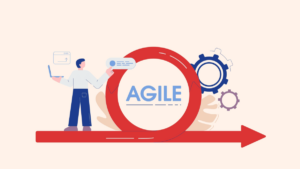Accept Cookies & Privacy Policy?
We use cookies to ensure that we give you the best experience on our website. If you continue to use this site we will assume that you accept and understand our Privacy Policy, and our Terms of Service.
DevOps is often much more than just a mutual collaboration effort between the development and the operations teams working together. And it’s definitely much more than deploying industry standard methodologies, tools and practices. DevOps is a reformative mindset, a shift in the software work culture, where teams adopt highly progressive and adaptive ways of working together.
DevOps culture implies all developers to imbibe the user POV by gaining a better understanding of their requirements and needs. Operations teams involved in the development process , add-in the maintenance requirements and customer needs.Following the primary principles that help DevOps teams deliver applications and services much faster alongside a higher quality than most organizations still working in the traditional software development models.
The core idea behind DevOps is collaboration. Development and operations teams coalesce together forming a functional team that inter-communicates, exchanges feedback, and collaborates throughout the complete development and deployment cycle. Often, development and operations teams merge into one team that works across the entire software/application lifecycle.
The members of a DevOps team are responsible for ensuring uncompromising quality deliverables across every aspect of the product. Leading to ‘full stack’ development, with teams owning complete backend-to-frontend responsibilities of a feature or product. Teams will focus on a feature or project throughout the complete lifecycle from ideation to delivery. This advanced level of investment and attachment from the team leads to a higher quality output.
Customers expect and demand always-on, always available services. DevOps is well suited to supporting “always-on” software, or software as a service. It reinforces the cycle of continuous deployment, feedback, and maintenance or incident response that teams need to keep always-on services, always on.
DevOps is a cultural shift where teams embrace a software engineering culture, workflow, and toolset in sync with the requirements attuning its importance to the software architecture, design, and development.
Ensuring developers have a greater understanding of user requirements and needs. The core values of a DevOps culture include increased transparency, communication, and collaboration across teams.
There are three primary benefits for DevOps: technical benefits, cultural benefits, and business benefits. The technical benefits include lower complexity, continuous delivery, and speedy resolutions. DevOps engineers usually deploy higher-quality code that’s much faster than traditional siloed teams.
The added benefits are more productive and highly efficient teams, and happier customers. On the business end, the benefits include greater cooperation and trust building that fastens delivery ensuring stable operating environments.
Often the developers who wrote code worked separately from the operations team that supported the code inline of production. This resulted in inefficient processes and a lack of collaboration between these two highly siloed teams.
DevOps was the solution that bridges the gap between these teams so they work in tandem. DevOps brings the best of the both worlds including punching together the skills, processes, and tools together from both development and operations teams equally.
The significant turning point or the so-called cornerstone for continuous DevOps testing services is testing the software at every stage of its development life cycle. This significantly helps in evaluating the quality of the software in every possible step and makes way for continuous integration (CI) and continuous delivery (CD). Agile Methodology complements this as well, with Thought Frameworks approaching this ideation by following through the best business practices of integrating QA testing into the Continuous Integration (CI) and Continuous Delivery(CD) processes in the DevOps pipeline.
Importance of DevOps Continuous Testing Services
Continuous Testing in DevOps
The cornerstone for continuous DevOps testing services is testing the software at every stage of its development life cycle. This helps in evaluating the quality of the software in every step and makes way for continuous integration (CI) and continuous delivery (CD). Agile Methodology complements this, Thought Frameworks approaches and follows the best business practices by integrating testing into Continuous Integration (CI) and Continuous Delivery(CD) in DevOps pipeline.
Continuous Testing in Agile DevOps PipelineContinuous Testing in Agile DevOps Pipeline.
What happens when you don’t do DevOps Continuous Testing
In the traditional software development prototype, the requirement occupies the X-axis of the plan and delivery occupies the Y-axis. This placement will have a negative impact in terms of cost, time, and errors. For instance, a defect that is discovered and corrected once the software has entered production will cost a fortune as compared to it being identified in the requirement phase.
DevOps Continuous Testing Services Bug Hunt Process
Microservices Architecture Testing:
The goal of the microservices architecture is to decentralize the development process by breaking down monolithic applications and releasing services separately and often.
The goal of the microservices architecture is to decentralize the development process by breaking down monolithic applications and releasing services separately and often.
All of these operations are included in Microservices Architecture Testing, but it requires a methodology to support it. DevOps being an exquisite fit for all the requirements that Microservices Architecture testing has to offer. It allows for experimentation and innovation where customer experience and delight are of prime importance.
A support system for Continuous testing is achieved via DevOps tools throughout the CI/CD process to achieve seamless customer experience.
1. Automation Testing Tools
2. Performance Testing Tools
A Typical DevOps Testing Service Environment
A continuous & automated Testing process enables continuous & faster delivery of software.
Testing Spans every stage of the Software Development lifecycle (SDLC).
Employing different forms of testing in SDLC minimizes backing tracking of an already detected error.
Testing has now evolved to Shared Testing – this allows everyone to understand the impact significance behind each change.

I’ve been in the Agile trenches for years now—coaching teams, facilitating sprints, navigating the choppy waters of transformations that promised the moon but barely delivered a sprint review. If there’s one thing I’ve learned, it’s that Agile is like water—it evolves, it adapts, and sometimes, it drowns you if you’re not prepared.

So picture this: You’re the air traffic controller of a chaotic airport where the planes (developers) don’t always listen, the passengers (stakeholders) want to change destinations mid-flight, and the weather (unforeseen blockers) is always unpredictable.

Imagine a world where testing is no longer a bottleneck. No more endless cycles of manual effort, no more missed defects due to human fatigue, and no more panic at the eleventh hour before a major ERP rollout.

Imagine a world where testing is no longer a bottleneck. No more endless cycles of manual effort, no more missed defects due to human fatigue, and no more panic at the eleventh hour before a major ERP rollout.

Let’s talk about GenAI and testing in 2025—the wild west of technology where machines are not just smart, but scary smart. GenAI (that’s Generative AI for the uninitiated) is running the show everywhere. It’s writing poetry, designing ads, debugging code, and probably plotting to take over my job as I write this blog.

Ah, 2024—you’ve been a year, haven’t you? For us at Thought Frameworks, this year wasn’t just about running the usual QA/QE playbook. Nope, we went full throttle into the future—tinkering, testing, and transforming everything from ERP systems to the ever-evolving world of SAP, GenAI, and security testing.
Accept Cookies & Privacy Policy?
We use cookies to ensure that we give you the best experience on our website. If you continue to use this site we will assume that you accept and understand our Privacy Policy, and our Terms of Service.
| Cookie | Duration | Description |
|---|---|---|
| cookielawinfo-checkbox-analytics | 11 months | This cookie is set by GDPR Cookie Consent plugin. The cookie is used to store the user consent for the cookies in the category "Analytics". |
| cookielawinfo-checkbox-functional | 11 months | The cookie is set by GDPR cookie consent to record the user consent for the cookies in the category "Functional". |
| cookielawinfo-checkbox-necessary | 11 months | This cookie is set by GDPR Cookie Consent plugin. The cookies is used to store the user consent for the cookies in the category "Necessary". |
| cookielawinfo-checkbox-others | 11 months | This cookie is set by GDPR Cookie Consent plugin. The cookie is used to store the user consent for the cookies in the category "Other. |
| cookielawinfo-checkbox-performance | 11 months | This cookie is set by GDPR Cookie Consent plugin. The cookie is used to store the user consent for the cookies in the category "Performance". |
| viewed_cookie_policy | 11 months | The cookie is set by the GDPR Cookie Consent plugin and is used to store whether or not user has consented to the use of cookies. It does not store any personal data. |
Ready for a Quality Software?
Let’s Dig Deep Into Your Thought!